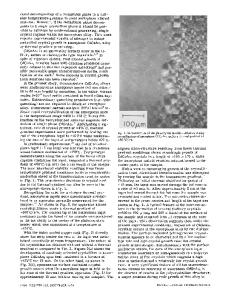Ball-milling-induced crystallization and ball-milling effect on thermal crystallization kinetics in an amorphous FeMoSiB
- PDF / 858,985 Bytes
- 9 Pages / 612 x 792 pts (letter) Page_size
- 30 Downloads / 324 Views
I.
INTRODUCTION
AMORPHOUS solids are thermodynamically metastable and transform into more stable states under appropriate circumstances. Crystallization is such a transformation. During crystallization, an amorphous phase crystallizes into one or more metastable or stable polycrystalline phases. Crystallization can be induced by heat treatment[1] or irradiation,[2] for example. Crystallization of amorphous solids upon thermal annealing (‘‘thermal crystallization’’) has been extensively investigated in many systems in the past decades.[1] The main reason is either to control the thermal crystallization process in order to maintain the excellent properties of the amorphous materials or to explore new types of materials with novel properties, such as nanocrystalline materials[3,4] and nanocrystalline/amorphous composites.[5] Moreover, thermal crystallization of amorphous solids provides a model system for studying many fundamental subjects in materials science, such as the kinetics and thermodynamics of phase transformation in a homogeneous (amorphous) matrix,[6] crystal nucleation and growth at high undercoolings,[7] grain boundary or interface formation during crystallization,[8] etc. Recently, it was reported that severe mechanical deformation may also induce crystallization in amorphous alloys; the process is called ‘‘mechanically driven crystallization’’ (MDC). He et al.[9] found precipitation of crystals from amorphous Al-based alloys by bending the amorphous ribbon at room temperature. Trudeau et al.[10,11,12] noticed a crystallization process occurring in an Fe-based amorphous F.Q. GUO, Postgraduate Student, and K. LU, Professor, are with the State Key Laboratory for RSA, Institute of Metal Research, Chinese Academy of Sciences, Shenyang 110015, People’s Republic of China. Manuscript submitted December 12, 1995. METALLURGICAL AND MATERIALS TRANSACTIONS A
alloy when it was subjected to high-energy ball milling. They reported that the mechanically induced crystallization kinetics during ball milling differ from that of thermal crystallization and is composition dependent. Although subsequent studies in several materials showed that amorphous alloys crystallize during ball milling, controversial opinions on the MDC mechanism still remain.[13,14] However, experimental evidence[11] shows that the MDC of amorphous alloys can lead to extremely fine equiaxed crystallites with a narrow size distribution. Thus, MDC provides a new approach to production of ultrafine microstructured materials that may demonstrate useful properties. Therefore, it is worthwhile to study the MDC process in different amorphous alloys and explore potential application of this new process. For a better understanding of the MDC process in amorphous alloys, a systematic comparative investigation between the thermal and the mechanical driven crystallization processes is needed. In this work, we studied the structural evolution of a melt-spun amorphous FeMoSiB alloy during ball milling by means of structural and thermal analysis techniques. The
Data Loading...







